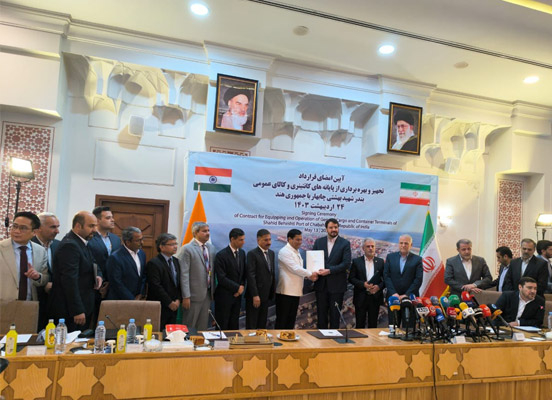
By K S Tomar
It was in January 2003 that a history of sorts was created following the signing off of a strategic roadmap of close cooperation by late Prime Minister Atal Bihari Vajpayee with then-Iranian President Muhammad Khatami. The main project happened to be the Chabahar port development with a vast potential to link South Asia with the Persian Gulf, Afghanistan, Central Asia, and Europe.
India spent about $100 million to construct a 218 km road from Delaram in western Afghanistan to Zaranj on the Afghan-Iran border to connect with Chabahar. However, the project progressed at a snail’s pace. The foundation of the agreement was laid when Prime Minister Narender Modi met Iran’s late president, Ebrahim Raisi, in Johannesburg in August 2023 on the sidelines of the BRICS Summit where both leaders gave a go-ahead to respective governments to finalize the timeframe to make it a reality in future.
Chabahar is a deep-water port in Iran's Sistan Baluchistan province. Located in the open sea, the port is closest to India, allowing the country to bypass neighboring Pakistan in the future, to secure access to large cargo ships for trade with Europe and other countries.
In this backdrop, the entire world is looking at India’s next move to negotiate the complex global landscape of the threat of sanctions by the United States to convince it, on the analogy of relaxing sanctions to exempt India from importing crude oil during Covid-19. It will be in the strategic and geopolitical interests of both countries besides checkmating the growing influence of China in the region posing security risks.
External Affairs Minister, Subrahmanyam Jaishankar, has given ample indication of India’s resolve to dilute the US threat perception of imposing sanctions following a 10-year agreement signed by the Indians Ports Global Limited (IPGL) with Iran’s Port and Maritime Organization to operate Chabahar port -- a gateway to trade in central and Europe, bypassing Pakistan. IPGL will invest $120 million to operate and equip the port for a defined period besides an offer of credit window in rupees equivalent to $250 million for mutually identified projects linked to the port.
India's long-term plan to counter China's BRI
Diplomatic experts have ruled out any possibility of a showdown between America and India over the signing of the Chabahar agreement as President Joe Biden and Prime Minister Narendra Modi have been working to take strategic relations to the next level.
Further, India has played down the hue and cry over the US threat to impose sanctions, especially when Jaishankar has expressed the belief not to blow it out of proportion. The foreign minister has made it clear that the US must not take a narrow view of the entire matter because India will be able to convince America of the logic behind the agreement which had been made in 2017 when a special concession was given to import crude oil from Russia which had benefited Europe and the US as well.
America had reacted owing to strict sanctions that are in force against Iran and made it clear that any entity engaging in business deals with Iran must be aware of the potential risks and repercussions, including the possibility of facing US sanctions. But the US is also aware that a showdown with India may prove counterproductive as it will create an imbalanced playing field, thereby encouraging China to fish in the troubled waters. Hence, the chances of such extreme action seem to be remote.
In addition, India has formulated the project with a long-term plan to counter China’s Belt and Road Initiative (BRI) as the Chabahar port project seeks to build road, rail, shipping network, etc via India’s near West to Western Europe topography and other relevant ingredients.
India has assessed the future impact of the China-Pakistan Economic Corridor (CPEC), and Tehran realized the strategic importance of the port in 1970 during the Iran-Iraq war, making it obligatory for both nations to get over the hurdle of America’s onslaught.
India is also worried about China's CPEC corridor as it passes through the Pakistan-occupied Kashmir (PoK), which creates a security threat, and hence unacceptable. It is pertinent to note that India successfully provided humanitarian assistance to Afghanistan during COVID-19 and transported 2.5 million tonnes of wheat and 2000 tonnes of pulses via Chabahar port as Pakistan refused to give way. India also supplied 40,000 liters of environment-friendly pesticides (Malathion) to Iran to fight against locust attacks.
The United States and China's growing influence
It is an open secret that China has expressed its ambition to become a superpower to replace America, which is why it is implementing its Expansionist Policy to bring poor and smaller nations under its fold. China has already entrapped Pakistan, Nepal, and Maldives in Asia which is worrisome to India also. Right now, the United States does not have any potential ally that can take on China or check its tendency to grow bigger, except India. The economic and glaring progress on different fronts like technology, space, infrastructure, etc has positioned India in the front row, hence it can act as a shield to America. Weakening for Russia has pushed it towards China which would like to expand ties with European nations also.
The proxy war in Ukraine and involvement in the Israel-Hama conflict have put America in a precarious situation which is a welcome development for China. Keeping in view these factors, the United States will have to tread cautiously and refrain from threatening friends like India, which will prove detrimental.
US presidential elections
President Biden will have to give due consideration to the importance and relevance of the Indian Diaspora in the United States and think about the fallout of the decision to invite a showdown with India. The track record shows that Indian diasporic politics are at a vintage position in the US when compared to any other country in the world. More than five million Americans of Indian descent, primarily first and second generations of Indian immigrants are well settled, hence they do have their role to influence presidential polls. Any confrontation with India may have an adverse impact on those who contribute a lot to the progress and development of America.
In the final assessment, analysts opine that today's India is not the India of 1974 when America imposed sanctions after a nuclear test which continued for 20 years thereby causing a cascading effect. Though India suffered due to sanctions, it marched ahead on various fronts like technology, developing missiles, economy, etc. At present, India matters in the world arena which gives it sole authority to decide in the interests of the people of the country. The current agreement must be seen with a wider telescopic vision to refrain from any unwarranted and illogical action like imposing sanctions.

The writer is a political analyst and senior journalist based in Shimla.
(The views expressed are not necessarily those of The South Asian Times)